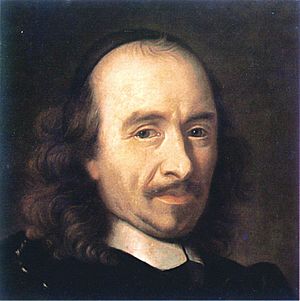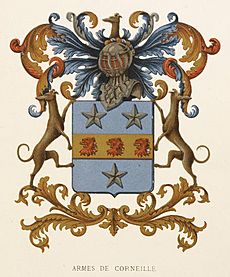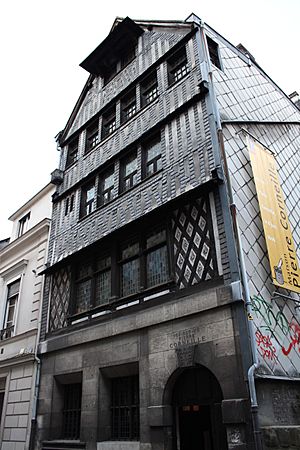Pierre Corneille facts for kids
Quick facts for kids
Pierre Corneille
|
|
|---|---|

Detail from a portrait by Charles Le Brun
|
|
| Born | 6 June 1606 Rouen, Normandy |
| Died | 1 October 1684 (aged 78) Paris |
| Occupation | Playwright |
| Nationality | French |
| Genre | Tragedy, comedy |
| Notable works | Le Cid |
| Spouse | Marie de Lampérière |
| Relatives | Thomas Corneille |
Pierre Corneille (French pronunciation: [pjɛʁ kɔʁnɛj]; 6 June 1606 – 1 October 1684) was a famous French playwright. He is considered one of the three greatest French writers of plays in the 1600s. The other two were Molière and Racine.
When he was young, he got support from Cardinal Richelieu. Richelieu wanted to promote a certain style of plays. But Corneille later had disagreements with him. This was especially true about his most famous play, Le Cid. This play was about a Spanish warrior from the Middle Ages. A new group called the Académie française criticized it. They said it broke the rules of "classical unities." Despite this, Corneille kept writing popular tragedies for almost 40 years.
Contents
Biography of Pierre Corneille
Early Life and Education
Pierre Corneille was born in Rouen, France. His mother was Marthe Le Pesant, and his father, Pierre Corneille, was a respected lawyer. His younger brother, Thomas Corneille, also became a well-known playwright.
Corneille received a strict education from the Jesuits. Acting was part of his training at the Collège de Bourbon. When he was 18, he started studying law. However, he was not very successful as a lawyer.
Corneille's father helped him get two jobs in Rouen. While working there, he wrote his first play. It was a comedy called Mélite. He showed it to a group of traveling actors in 1629. They liked it and added it to their shows.
The play was a hit in Paris. Corneille then started writing plays regularly. He moved to Paris that same year. Soon, he became one of the leading playwrights in France. His early comedies were different from traditional French farces. They showed the refined language and manners of Paris society. Corneille called his comedies "a painting of the conversation of the gentry." His first true tragedy was Médée, which came out in 1635.
The Five Poets
In 1634, Corneille gained more attention. He was chosen to write poems for Cardinal Richelieu's visit to Rouen. Richelieu noticed Corneille and picked him to be part of Les Cinq Auteurs. This means "The Five Poets." The other poets were Guillaume Colletet, Boisrobert, Jean Rotrou, and Claude de L'Estoile.
Richelieu chose these five to create a new type of play. He wanted plays that focused on good values. Richelieu would give them ideas, and the writers would turn them into plays. But Richelieu's rules were too strict for Corneille. Corneille wanted to try new things outside these rules. This caused problems between them. After his first contract ended, Corneille left "The Five Poets." He went back to Rouen.
The Quarrel of Le Cid
After leaving Richelieu's group, Corneille wrote his most famous play. This play was Le Cid. It was based on an older play by Guillem de Castro. Both plays were inspired by the legend of Rodrigo Díaz de Vivar. He was a military hero in Medieval Spain.
The first edition of Le Cid in 1637 was called a tragicomedy. This meant it mixed elements of both tragedy and comedy. Le Cid was incredibly popular with the public. However, it caused a big argument about how plays should be written. This argument was known as the "Querelle du Cid" or "The Quarrel of Le Cid."
Cardinal Richelieu's Académie française recognized the play's success. But they decided it had flaws. One main reason was that it did not follow the "classical unities." These were strict rules for plays:
- Unity of Time: All the action in a play had to happen within 24 hours.
- Unity of Place: The play had to have only one setting.
- Unity of Action: The story had to focus on just one main conflict or problem.
The Académie was a new group that aimed to control cultural activities. Richelieu himself ordered them to analyze Le Cid. Many people also criticized the play for being "immoral." These attacks were based on the idea that theater should teach good morals. The Académie's findings were written down by Jean Chapelain. Even other famous writers like Georges de Scudéry strongly criticized the play.
The controversy and the Académie's decision were hard for Corneille. He decided to return to Rouen. When his plays were reviewed badly, Corneille often withdrew from public life. He stayed quiet for a while. But he was still thinking about the issues and made many changes to Le Cid.
Later Works
Corneille wrote many plays after returning to the stage. He wrote about one play a year for 14 years after 1659. However, his later plays were not as successful as his earlier ones. Other writers were becoming more popular.
In 1670, Corneille and Jean Racine, another famous playwright, were challenged. They both had to write plays about the same event. Neither knew the other had the same challenge. When both plays were finished, most people thought Corneille's Tite et Bérénice (1671) was not as good as Racine's play (Bérénice).
Molière was also very well-known at this time. Corneille even worked with Molière (and Philippe Quinault) on the comedy Psyché (1671). Most of the plays Corneille wrote after his return were tragedies. These included La Toison d'or (The Golden Fleece, 1660), Sertorius (1662), Othon (1664), Agésilas (1666), and Attila (1667).
He wrote his last play, Suréna, in 1674. It was not successful at all. After this, he stopped writing plays for good. He died at his home in Paris in 1684. His grave in the Église Saint-Roch did not have a monument until 1821.
Legacy of Pierre Corneille
The writer and philosopher Voltaire admired Corneille. With help from the Académie française, Voltaire created a twelve-volume set of Corneille's plays with notes. This was Voltaire's biggest work of literary criticism. Voltaire believed Corneille did for the French language what Homer did for Greek. He showed that French could be used for great art.
Voltaire wanted to defend classic French literature. At the time, foreign writers like William Shakespeare were becoming very popular. In the first edition of his notes (1764), Voltaire focused on Corneille's best works. He had only mild criticisms. But in the second edition, ten years later, Voltaire was more critical. He added many more notes and was more negative.
People already had very different opinions about Corneille. Voltaire's work made the debate even stronger. Some critics thought his criticisms were too picky or came from jealousy. In the 1800s, opinions changed again. Napoleon preferred Corneille over Voltaire. This helped make Corneille's reputation as a playwright stronger, while Voltaire's went down.
List of Works
- Mélite (1629)
- Clitandre (1630–31)
- La Veuve (1631)
- La Galerie du Palais (1631–32)
- La Suivante (1634)
- La Place royale (1633–34)
- La Comédie des Tuileries (by Les Cinq Auteurs, Act III by Corneille, 1635)
- Médée (1635)
- L'Illusion comique (1636)
- Le Cid (1637)
- Horace (1640)
- Polyeucte (1642)
- La Mort de Pompée (1643)
- Cinna (1643)
- Le Menteur (1643)
- Rodogune (1644)
- La Suite du Menteur (1645)
- Théodore (1645)
- Héraclius (1647)
- Don Sanche d'Aragon (1650)
- Andromède, (1650)
- Nicomède, (1651)
- Pertharite, (1651)
- L'Imitation de Jésus-Christ (1656)
- Oedipe (1659)
- Trois Discours sur le poème dramatique (1660)
- La Toison d'or (1660)
- Sertorius (1662)
- Sophonisbe (fr) (1663)
- Othon (1664)
- Agésilas (1666)
- Attila (1667)
- Tite et Bérénice (1670)
- Psyché (with Molière and Philippe Quinault, 1671)
- Pulchérie (1672)
- Suréna (1674)
See also
 In Spanish: Pierre Corneille para niños
In Spanish: Pierre Corneille para niños
- Cornelian dilemma, a term named after Corneille










